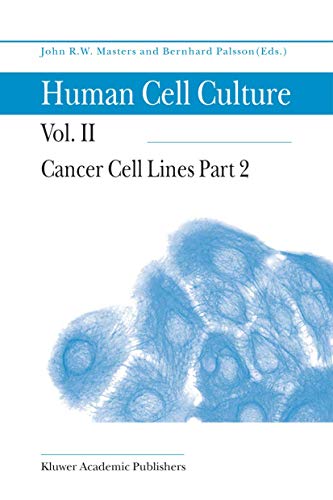Cancer Cell Lines Part 2 (Human Cell Culture, 2) - Hardcover

"synopsis" may belong to another edition of this title.
- PublisherSpringer
- Publication date1999
- ISBN 10 0792358783
- ISBN 13 9780792358787
- BindingHardcover
- Number of pages387
- EditorMasters John, Palsson Bernhard Ø
Buy New
Learn more about this copy
Shipping:
US$ 5.24
Within U.S.A.
Top Search Results from the AbeBooks Marketplace
CANCER CELL LINES PART 2 (HUMAN
Book Description Condition: New. New. In shrink wrap. Looks like an interesting title! 1.5. Seller Inventory # Q-0792358783
Cancer Cell Lines Part 2 (Human Cell Culture) [Hardcover ]
Book Description Hardcover. Condition: new. Seller Inventory # 9780792358787
Human Cell Culture : Cancer Cell Lines
Book Description Condition: New. Seller Inventory # 756304-n
Cancer Cell Lines Part 2 (Human Cell Culture, 2)
Book Description Condition: New. Seller Inventory # ABLIING23Feb2416190183366
Cancer Cell Lines Part 2
Book Description Gebunden. Condition: New. Dieser Artikel ist ein Print on Demand Artikel und wird nach Ihrer Bestellung fuer Sie gedruckt. Continuous cell lines derived from human cancers are the mostwidely used resource in laboratory-based cancer research. The first 3 volumes of this series on Human Cell Culture are devoted to these cancer cell lines. The chapters in these first 3 volumes hav. Seller Inventory # 5968989
Cancer Cell Lines Part 2
Book Description Condition: New. PRINT ON DEMAND Book; New; Fast Shipping from the UK. No. book. Seller Inventory # ria9780792358787_lsuk
Cancer Cell Lines Part 2
Book Description Buch. Condition: Neu. Druck auf Anfrage Neuware - Printed after ordering - Continuous cell lines derived from human cancers are the mostwidely used resource in laboratory-based cancer research. The first 3 volumes of this series on Human Cell Culture are devoted to these cancer cell lines. The chapters in these first 3 volumes have a common aim. Their purpose is to address 3 questions offundamental importance to the relevanceof human cancer cell lines as model systems of each type of cancer: 1. Do the cell lines available accurately represent the clinical presentation 2. Do the cell lines accurately represent the histopathology of the original tumors 3. Do the cell lines accurately represent the molecular genetics of this type of cancer The cancer cell lines available are derived, in most cases, from the more aggressive and advanced cancers. There are few cell lines derived from low grade organ-confined cancers. This gap can be filled with conditionally immortalized human cancer cell lines. We do not know why the success rate for establishing cell lines is so low for some types of cancer and so high for others. The histopathology of the tumor of origin and the extent to which the derived cell line retains the differentiated features of that tumor are critical. The concept that a single cell line derived from a tumor at a particular site is representative oftumors at that site is naïve and misleading. Seller Inventory # 9780792358787
Human Cell Culture : Cancer Cell Lines
Book Description Condition: New. Seller Inventory # 756304-n
Cancer Cell Lines Part 2
Book Description Buch. Condition: Neu. This item is printed on demand - it takes 3-4 days longer - Neuware -Continuous cell lines derived from human cancers are the mostwidely used resource in laboratory-based cancer research. The first 3 volumes of this series on Human Cell Culture are devoted to these cancer cell lines. The chapters in these first 3 volumes have a common aim. Their purpose is to address 3 questions offundamental importance to the relevanceof human cancer cell lines as model systems of each type of cancer: 1. Do the cell lines available accurately represent the clinical presentation 2. Do the cell lines accurately represent the histopathology of the original tumors 3. Do the cell lines accurately represent the molecular genetics of this type of cancer The cancer cell lines available are derived, in most cases, from the more aggressive and advanced cancers. There are few cell lines derived from low grade organ-confined cancers. This gap can be filled with conditionally immortalized human cancer cell lines. We do not know why the success rate for establishing cell lines is so low for some types of cancer and so high for others. The histopathology of the tumor of origin and the extent to which the derived cell line retains the differentiated features of that tumor are critical. The concept that a single cell line derived from a tumor at a particular site is representative oftumors at that site is naïve and misleading. 396 pp. Englisch. Seller Inventory # 9780792358787
Cancer Cell Lines
Book Description Condition: New. A guide to the culture of human cells. It covers the culture of established cell lines from various types of human cancer. It is suitable for researchers in various aspects of medicine, biology, technology and immunology using human cells. Editor(s): Masters, John R. W.; Palsson, Bernhard O. Series: Human Cell Culture. Num Pages: 387 pages, biography. BIC Classification: PSF; PSV. Category: (P) Professional & Vocational; (UP) Postgraduate, Research & Scholarly; (UU) Undergraduate. Dimension: 234 x 156 x 22. Weight in Grams: 730. . 1999. Hardback. . . . . Seller Inventory # V9780792358787

